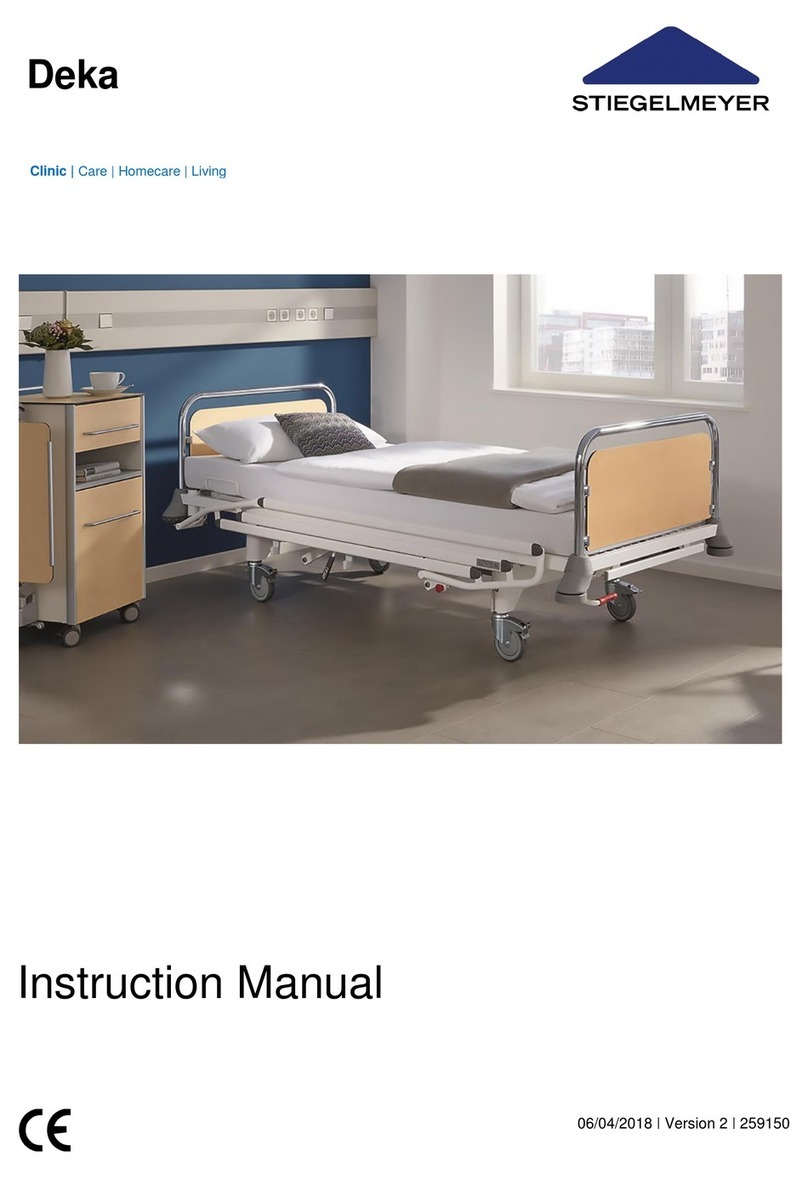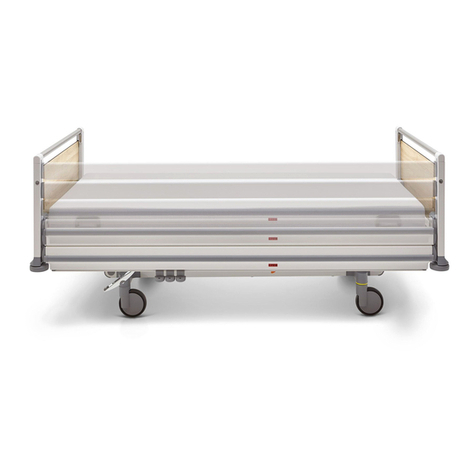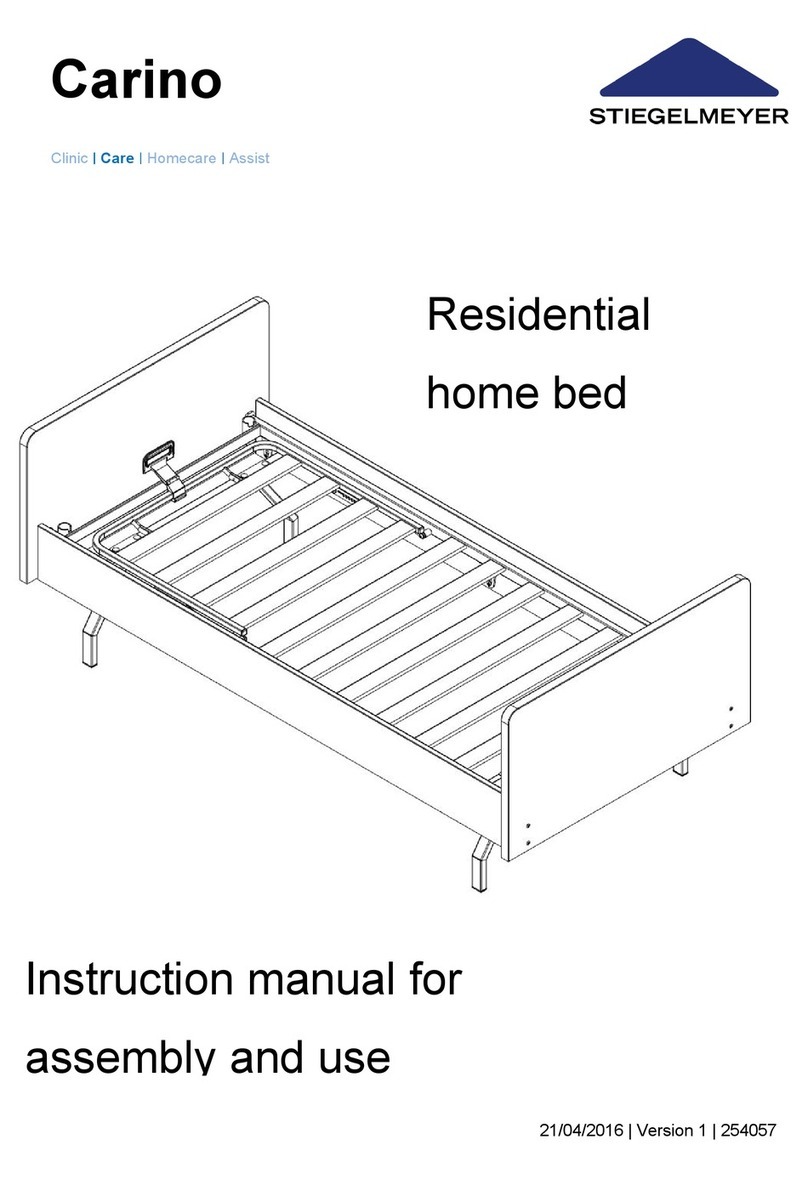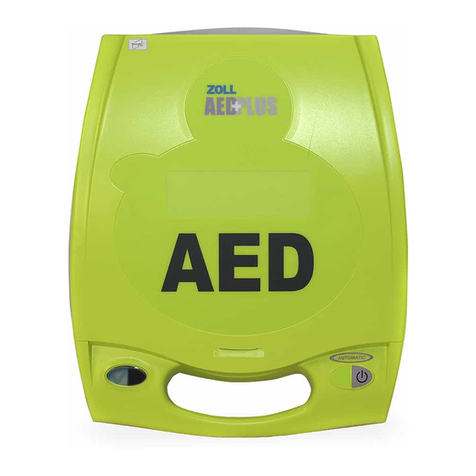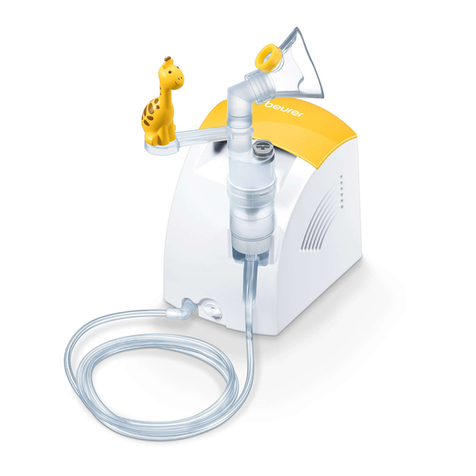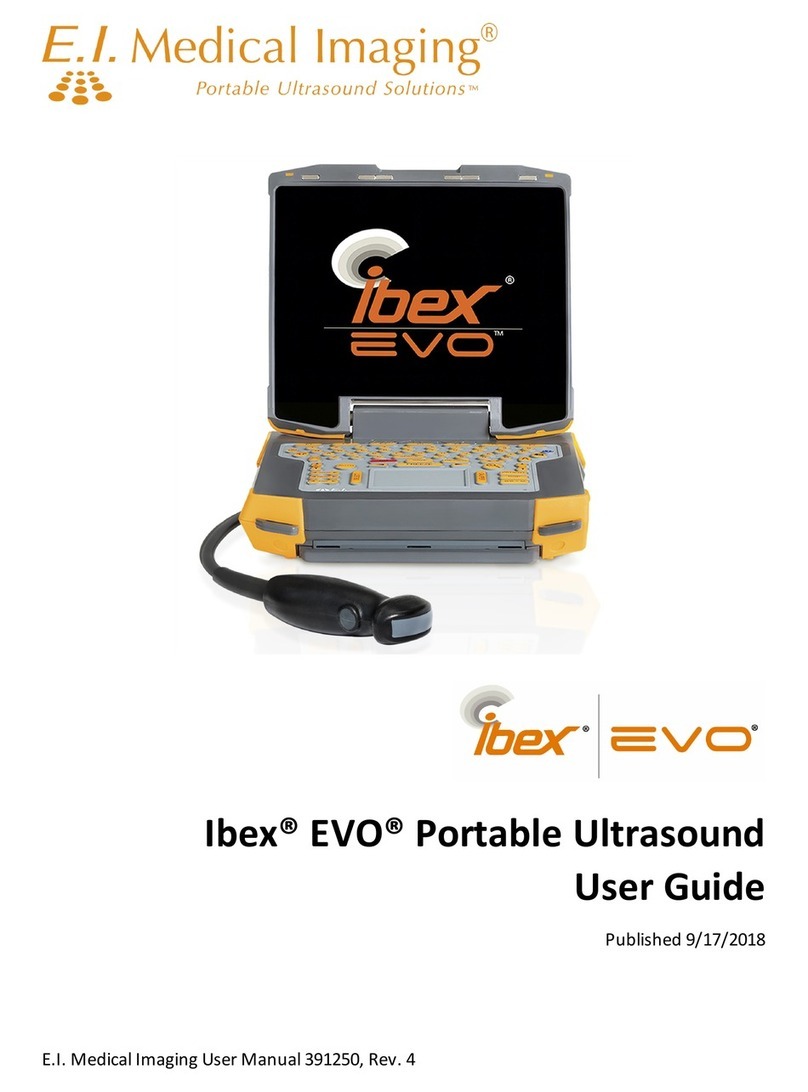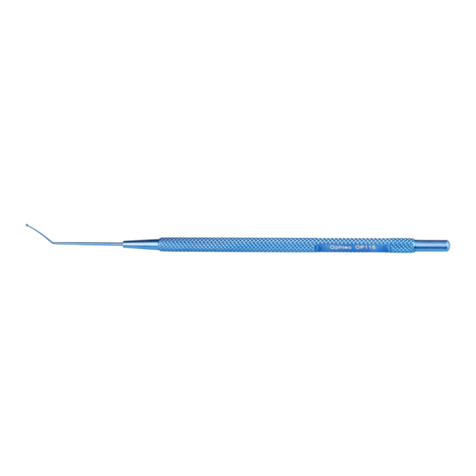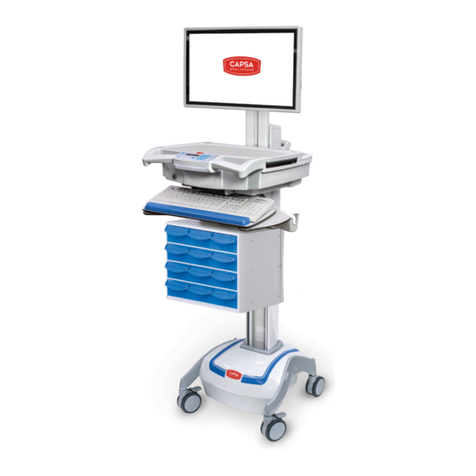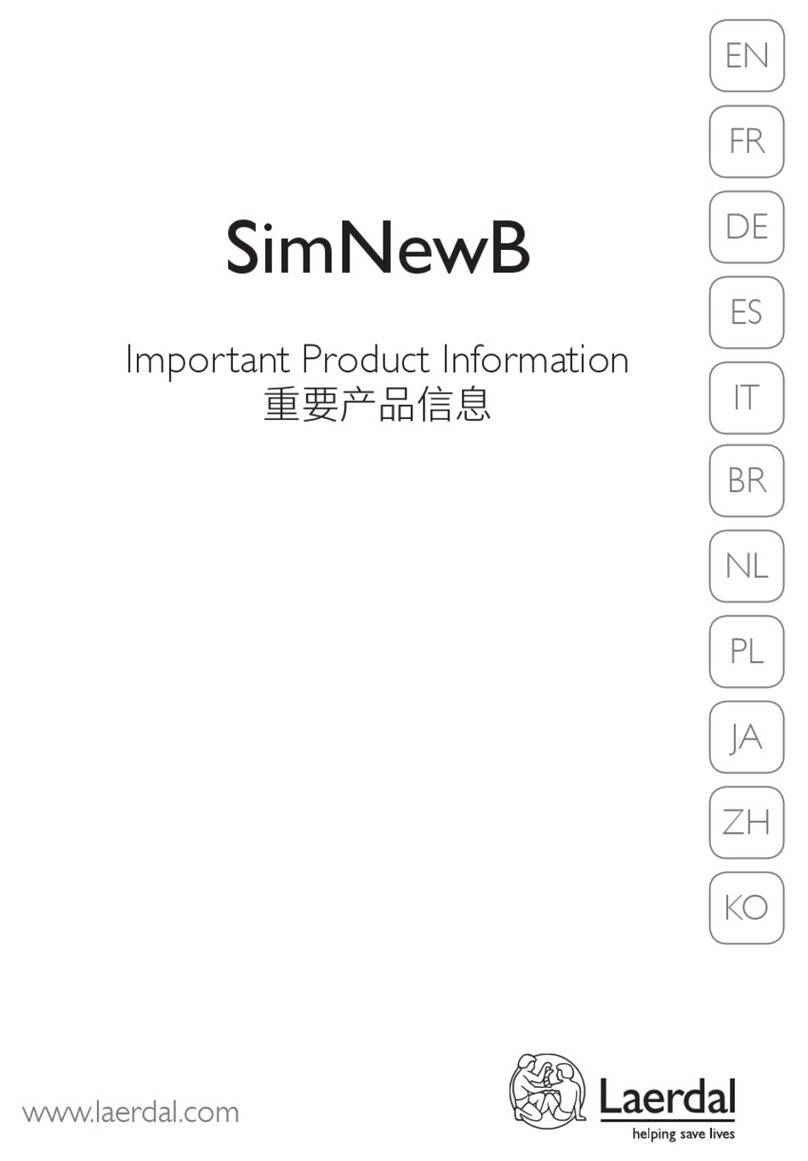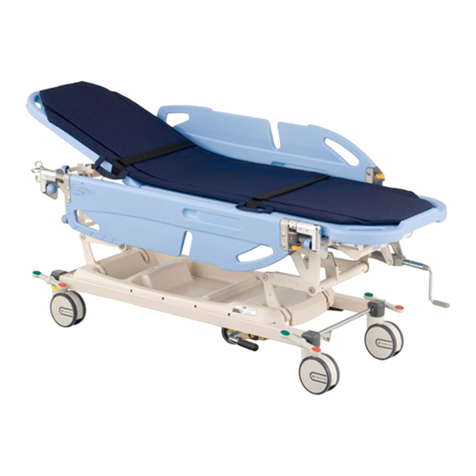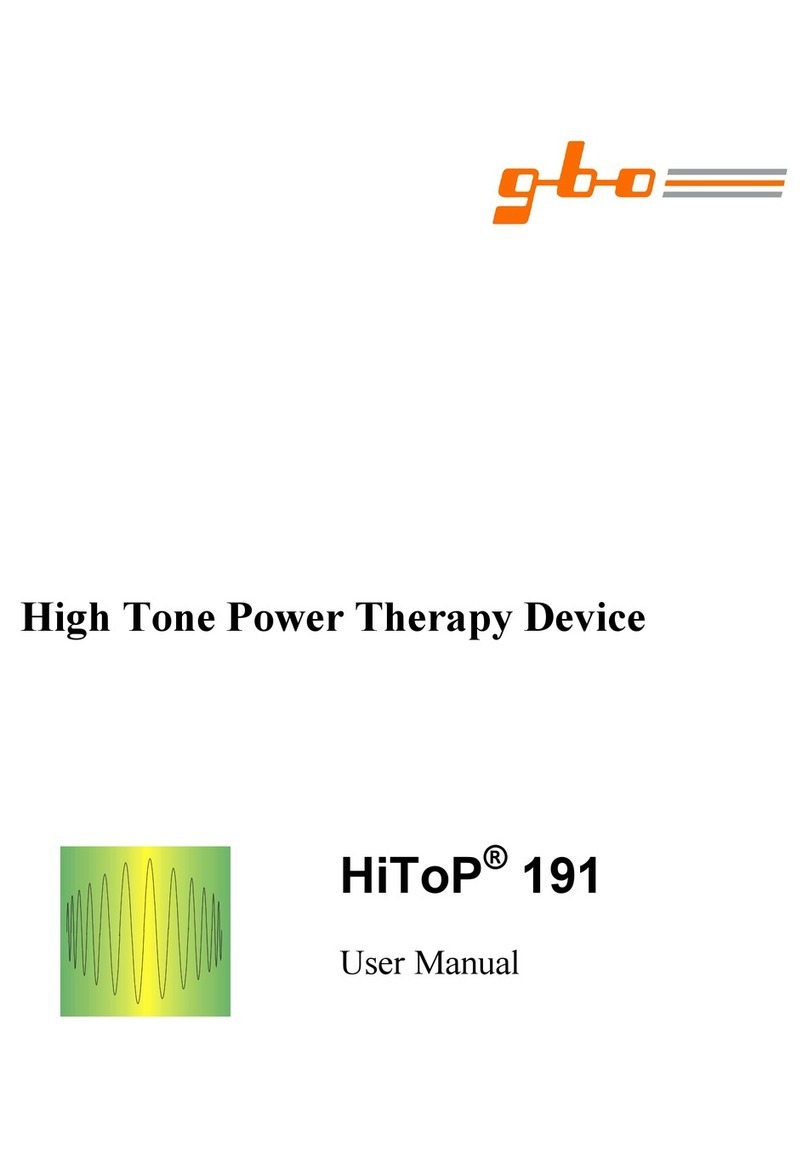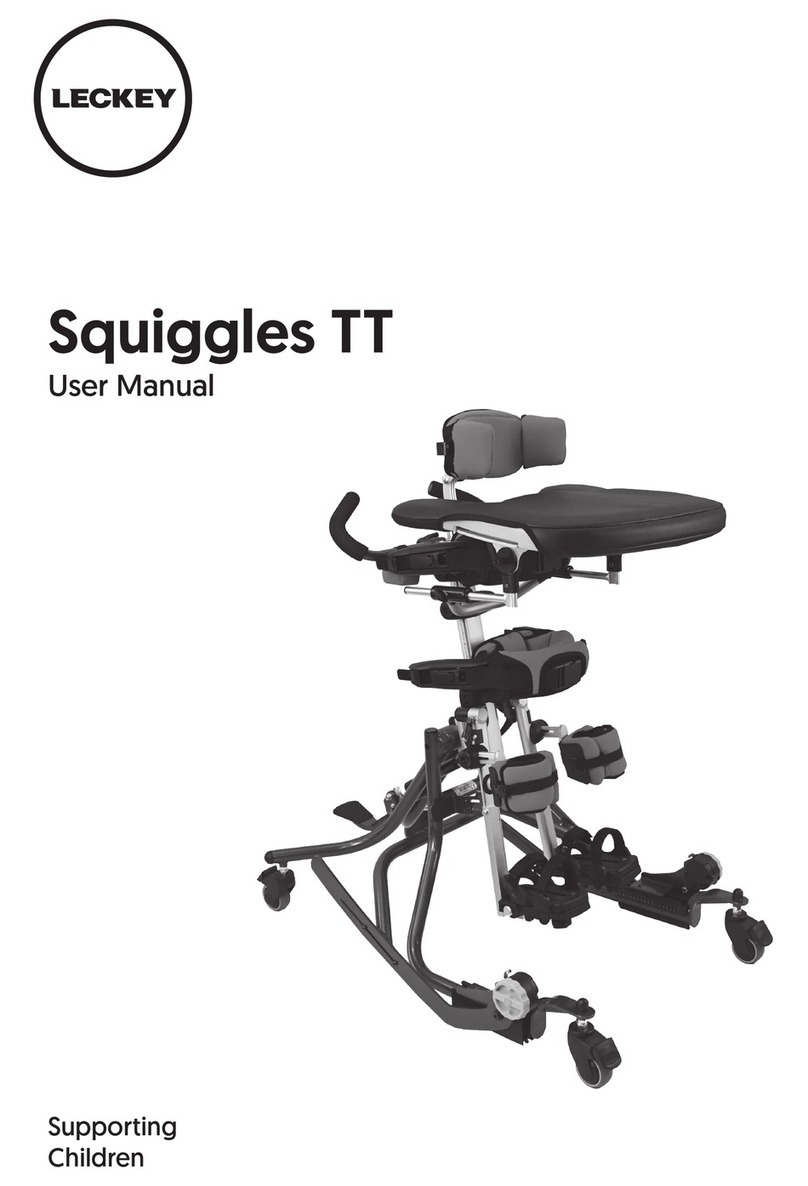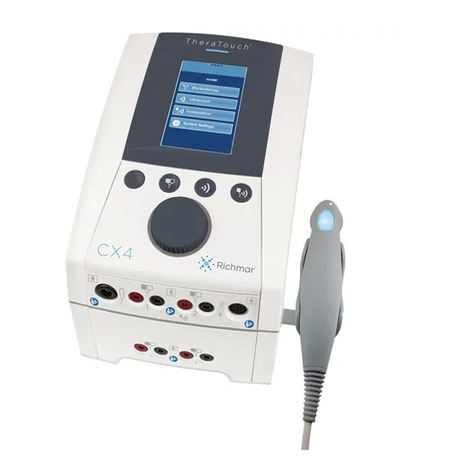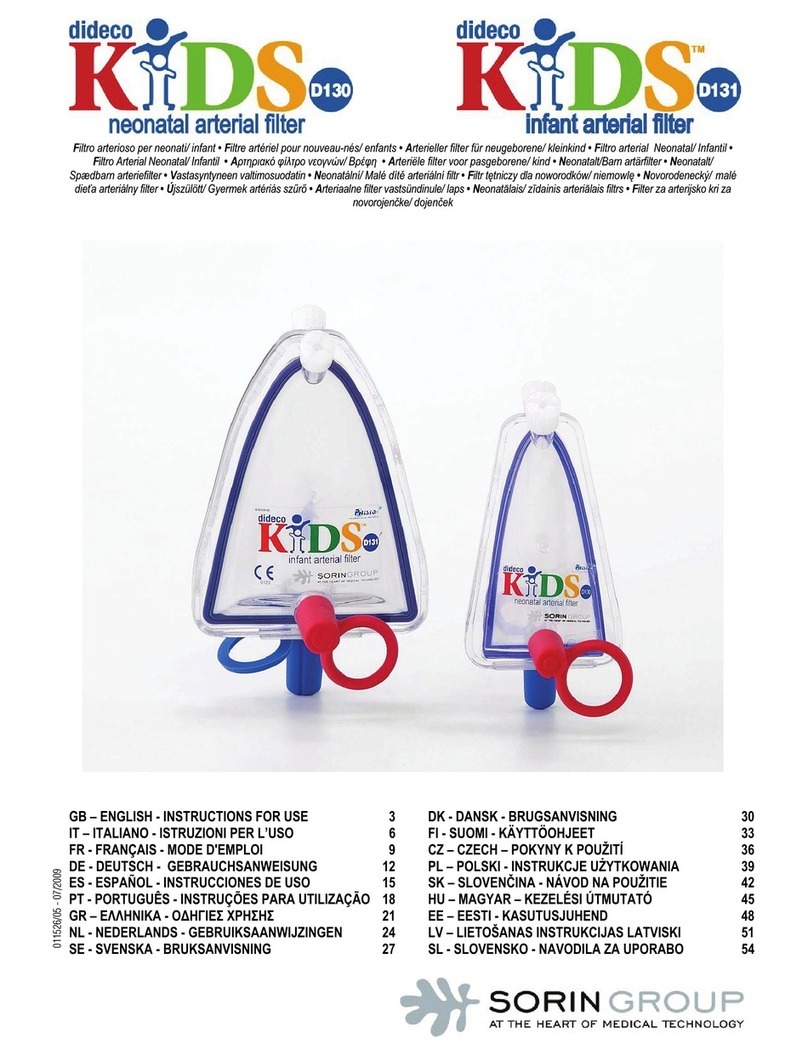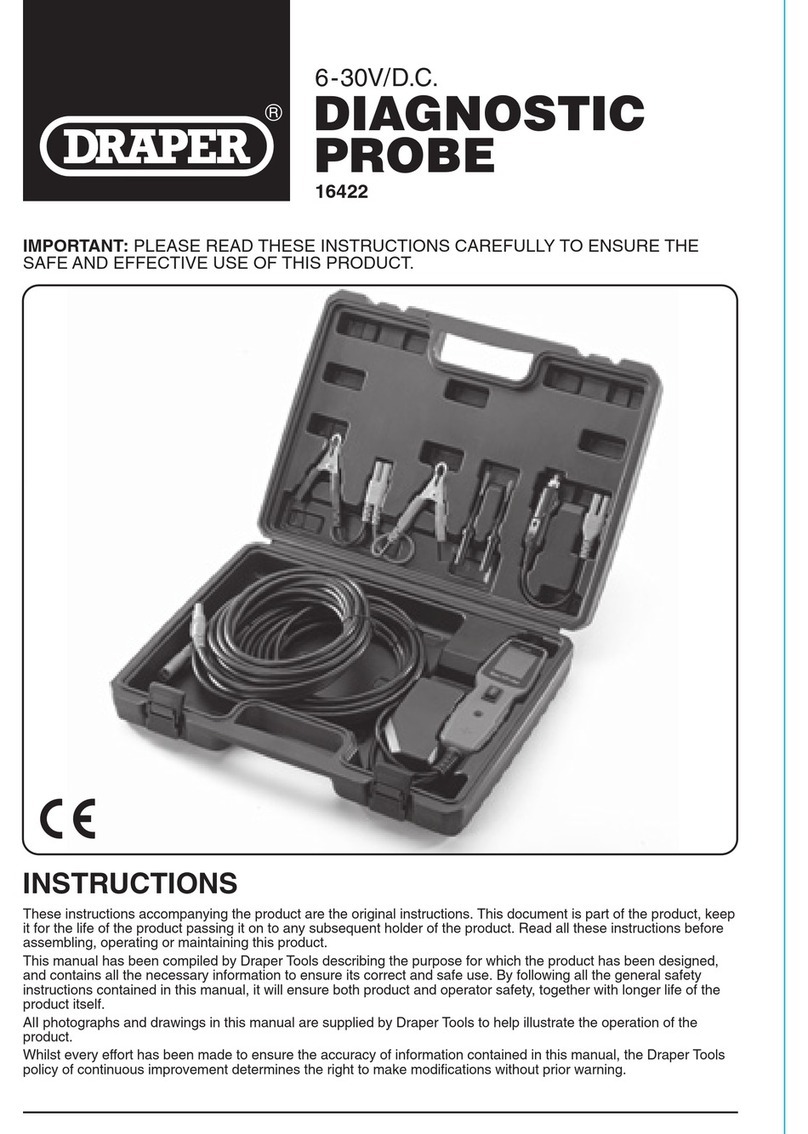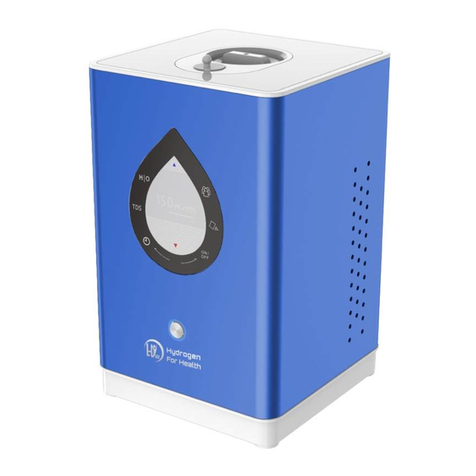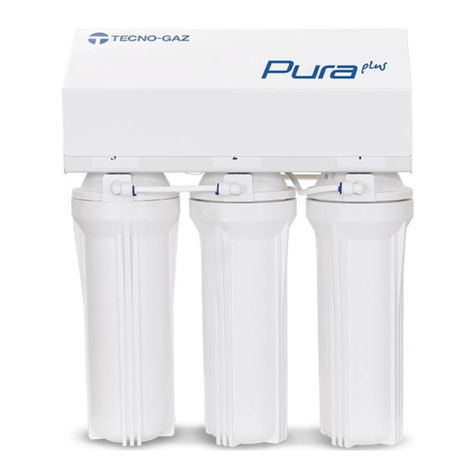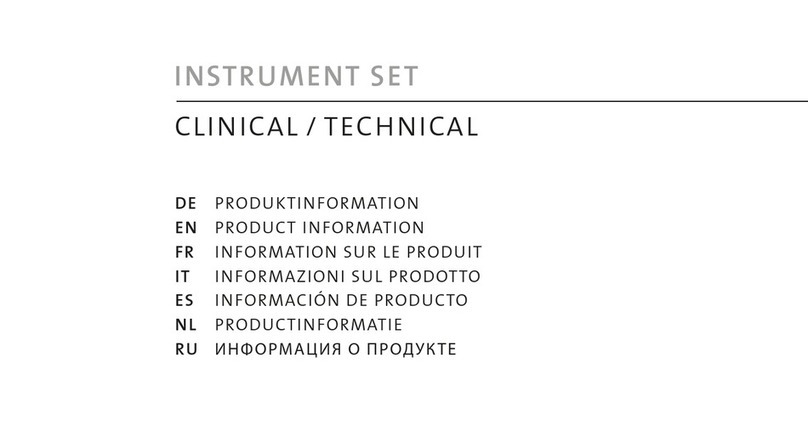Stiegelmeyer Deka User manual

Instruction Manual
Hospital Bed
Deka
Date: 2014-10-20 V2_220102

Instruction manual for the hospital bed Deka
Page 2
Deka hospital bed: Operational controls
Illustration with ¾ side guards (Illustration shows optional equipment)
1
Castors Ø 125 mm with individual locking, 4 in total
2
Operating lever (on both sides) for adjustment of the backrest (=pull on lever) and
thigh rest (=press lever down),
3
Foot pedal for adjustment of mattress base height: Press pedal down more than
once = to raise mattress base; raise pedal = to lower mattress base
4
Release lever (on both sides) to lock side guards: Pull on lever = to release
5
Universal holders, on both sides
5a
locking knobs for mattress base extension,on both sides
6
Release lever to tilt mattress base:Pull on lever = to release tilting
7
Wall deflection rollers, 4 in total at the outer corners;
8
Headboard/footboard, fully removable with laminate panel, can be removed
individually; (head end/foot end)
9
Grab handle for patient's lifting pole, with strap, height adjustable (accessory)
10
Patient's lifting pole (accessory)
11
Grab handles for backrest / side mattress guides, on both sides
12
Locating sleeve for patient's lifting pole / I.V. stand (2 in total, on left and right at
head end)
13
Side guard, integrated, on both sides
14
Grab handles for lower leg rest / side mattress guides, on both sides
Please note: In this instruction manual, numbers which appear in bold type and square
brackets [ ] refer to features described for the Deka hospital bed.
5a
1
8
4
9
6
7
10
3
12
2
11
14
8
1
13
5
5a
1
8
4
9
6
7
10
3
12
2
11
14
8
1
13
5

Instruction manual for the hospital bed Deka _____________________________________________
Page 3
Contents
1FOREWORD.................................................................................................................. 5
2GENERAL INFORMATION ............................................................................................ 6
2.1 Definition of the Groups of Persons Involved...................................................... 7
2.2 Safety Information................................................................................................... 8
2.2.1 Explanation of the safety symbols used ................................................... 8
2.2.2 Safety information for the operator .......................................................... 9
2.2.3 Safety information for the user................................................................... 9
2.3 Product description .............................................................................................. 11
2.3.1 Designated use .......................................................................................... 11
2.3.2 Special features ......................................................................................... 12
2.3.3 Materials used ............................................................................................ 12
2.3.4 Structural design ........................................................................................ 13
3PUTTING INTO SERVICE ............................................................................................. 14
3.1 Checklist: Inspection by the user ........................................................................ 15
3.2 Location Requirements ........................................................................................ 15
4OPERATION................................................................................................................ 17
4.1 Moving and Braking The Bed .............................................................................. 17
4.2 Manual adjustments ............................................................................................. 18
4.2.1 Safety Information ..................................................................................... 18
4.2.2 Adjusting the backrest .............................................................................. 19
4.2.3 Adjusting the thigh rest ............................................................................. 19
4.2.4 Adjusting the lower leg rest (optional) ................................................... 20
4.2.5 Adjusting the mattress base height ........................................................ 20
4.2.6 Tilting the mattress base............................................................................ 21
4.3 Attachments .......................................................................................................... 22
4.3.1 Location Sleeves for Patient’s Lifting Pole / I.V. Stands........................ 22
4.3.2 Grab handle (triangular handle) ............................................................ 23
4.3.3 Removing the Headboard/Footboard .................................................. 24
4.3.4 Moulded laminate headboards and footboards ................................ 24
4.3.5 Universal holder.......................................................................................... 25
4.3.6 Bed stripper................................................................................................. 25
4.3.7 Extending the Mattress Base .................................................................... 27
4.4 Side Guards............................................................................................................ 29
4.4.1 Safety information for side guards .......................................................... 29
4.4.2 ¾ side guards.............................................................................................. 30
5CLEANING AND DISINFECTION................................................................................ 31
6MAINTENANCE.......................................................................................................... 32
6.1 Servicing ................................................................................................................. 32
6.1.1 Servicing cycle ........................................................................................... 32
6.1.2 Servicing plan ............................................................................................. 33
6.1.3 Regular Safety Checks on Hospital Beds ............................................... 34
6.2 Replacement parts ............................................................................................... 37
6.3 Manufacturer’s address ....................................................................................... 37
1/8
5
4
7
6
3
11
10

Instruction manual for the hospital bed Deka
Page 4
7TROUBLESHOOTING ...................................................................................................38
7.1 Troubleshooting guide ......................................................................................... 38
8ACCESSORIES.............................................................................................................39
9TECHNICAL DATA.......................................................................................................40
9.1 Dimensions and Weights...................................................................................... 40
9.2 Adjustment range ................................................................................................. 40
9.3 Ambient conditions .............................................................................................. 42
9.4 Applied Standards................................................................................................ 42
9.5 Classification.......................................................................................................... 43
10 DISPOSAL INSTRUCTIONS...........................................................................................44
11 EC DECLARATION OF CONFORMITY ........................................................................45

Instruction manual for the hospital bed Deka _____________________________________________
Page 5
1Foreword
Dear Customer,
STIEGELMEYER would like to thank you for the confidence you have placed in us in
deciding to purchase this bed.
Each Deka hospital bed has been tested by the manufacturer for electrical safety
and functionality and left our factory in perfect condition.
It is very important that you read this instruction manual.
This applies not only when putting the bed into service for the first time, but also
for the everyday use of the bed. This manual is also a practical reference guide.
Keep the instruction manual at hand at all times.
This instruction manual informs you, as the operator, and your users about all the
functions necessary to ensure ease of operation and the safe handling of this
hospital bed.
We wish you and your users every success in caring for your patients and are
confident that this product enables us to make an important contribution.
Joh. Stiegelmeyer GmbH & Co. Kommanditgesellschaft
Disclaimer
This product is not licensed for use on the North American market. This applies
particularly to the United States of America. The distribution and use of the care
bed in these markets, also via third parties, is forbidden by the manufacturer.

Instruction manual for the hospital bed Deka
Page 6
2General Information
This instruction manual describes several different models of the Deka hospital
bed. The Deka is available in two widths of the mattress base: 85 + 90 cm.
It is possible that certain functions or features are described which are not
incorporated in your particular bed.
In the following text, the Deka hospital bed will be referred to simply as the bed.
Overview of standard features (●) and optional equipment/models (○).
Model
Feature
Deka
90cm
Deka
85cm
Side guards
¾- length, integrated, can be folded down
without
o
o
Classic
headboard/footboard: HPL panel - with Ø
32mm metal tubing
Intercontinental: Plastic design,
o
-
Castors
Ø 125mm, castors with individual locking
-
Ø 125mm, castors with central locking, with
steering lock
o
Ø 150mm, castors with central locking, with
steering lock
-
o
Wall deflection
rollers
4 pcs. horizontal working
4 pcs.: 2 pcs. horizontal + 2 pcs. horizontal and
vertical working
o
o
4 pcs. horizontal and vertical working
-
o
Mattress base
insert
Wire mesh (not removable)
Radiolucent backrest; remainder wire mesh
o
-
Hygienic Matress Support Platform
-
o
Lower leg rest
height
adjustment
Adjustment (Rastomat mechanism)
Bed stripper
Integrated under matress base at the foot
end
o
-
Bed extension
Integrated under matress base at the foot
end, 220mm extension range
-
Universal holder
Both sides
Colours
Argentum
o
o
Crystal white

Instruction manual for the hospital bed Deka _____________________________________________
Page 7
2.1 DEFINITION OF THE GROUPS OF PERSONS INVOLVED
In this instruction manual, the following groups of persons are defined as:
Operator
An operator (e.g. clinics, hospitals, hospital administrations) is every natural and
legal person with property rights to the Deka hospital bed. The operator is
responsible for the safe operation of this medical product.
Users
Users (e.g. medical specialists, nursing staff, doctors, carers, care workers) are
persons who, based on their training, experience or briefing, are qualified to
operate the bed on their own authority or to carry out works to the bed, or have
been instructed how to handle the bed. Furthermore, they can recognise and
avoid potential dangers and assess the clinical condition of the patient.
Patient
A patient is defined as a person who is infirm, in need of care, or disabled, and
occupies this bed.
It is strongly recommended that the operator or user instructs each new patient in
the bed functions that are important for him/her.

Instruction manual for the hospital bed Deka
Page 8
2.2 SAFETY INFORMATION
At the time of leaving the factory, this hospital bed represents state-of-the-art
technology.
Only use the hospital bed if you are absolutely certain that it is in perfect working
order!
The most important objective of the safety information is to prevent personal
injuries. Property damage is also to be avoided.
2.2.1 Explanation of the safety symbols used
In this instruction manual, the following safety symbols are used:
Risk of injury to persons
General danger. There is danger to life and health.
Risk of damage to property
Possible damage to the drive unit, materials or the environment.
Other advice
Useful tip. Eases handling of the hospital bed or improves
understanding.
The safety symbols used are not a substitute for the written safety information.
Therefore read the safety information and follow the instructions precisely!
All persons who work on or with this bed must be familiar with the contents of this
instruction manual and follow all the relevant safety advice.

Instruction manual for the hospital bed Deka _____________________________________________
Page 9
2.2.2 Safety information for the operator
In order to ensure the permanently safe operation of this medical product, with
no risk to patients, users or third parties, you must observe your relevant
national obligations (in accordance with the European Directive 93/42/EEC for
Medical Products)!
Using this instruction manual, which must be provided with the bed, ensure that
every user is instructed in the safe operation of the Deka hospital bed before
using it for the first time.
Draw every user’s attention to the possible hazards that can arise if the bed is
improperly used. This applies in particular to the use of electrical drives and
side guards!
Only allow this bed to be used by persons who have been instructed in its safe
operation!
Make sure that substitute staff are also sufficiently well instructed in the safe
operation of the bed!
Check to ensure that the safety instructions are adhered to!
Ensure that users know where this instruction manual is kept, in accordance
with the Operators of Medical Products Ordinance (MPBetreibV) § 9.
If the bed is in long-term use, test the functions and check for any visible
damage (see Chapter 0) after a reasonable period of time.
If any other equipment is attached to the bed, (e.g. compressors for
positioning systems, etc.), ensure that this is securely fastened and is
functioning properly.
Pay particular attention to:
-Safe hook-up of all loose connector cables, tubing, etc.
-Ensure that no multiple socket outlets are located under the bed
-Chapter 2.3.1 Designated use
If in doubt, contact the manufacturers of this equipment or Stiegelmeyer.
2.2.3 Safety information for the user
Ensure that the operator instructs you in the safe operation of this bed.
Read this instruction manual in order to prevent any injury or damage resulting
from incorrect operation.
Check each time before using the hospital bed to ensure that it is in perfect
working order (see Chapter 3.1)!
Ensure that no obstacles such as night tables, floor cable ducts or chairs could
impede adjustments to the bed.

Instruction manual for the hospital bed Deka
Page 10
If other equipment (e.g. compressors for positioning systems, etc.) is attached,
ensure that all items of equipment are fixed securely and function properly.
Pay particular attention to:
-Safe hook-up of all loose connector cables, tubing, etc.
-consult the manufacturer of the equipment in question, or Stiegelmeyer, if
there are any obscurities
If any damage or malfunction is suspected , take the bed out of service:
-indicate clearly that the bed is “Out of Order”
-report this immediately to the operator responsible
Route the mains cable of additional equipment in such a way
that it cannot be pulled, driven over or be endangered,
damaged or crushed by moving parts when the bed is operated.
Hazards due to electric shock and malfunctions can be avoided
in this way.
Make sure that the mattress base has travelled to its lowest position
before leaving the patient unattended. In this way, you greatly
reduce the risk of the patient injuring himself/herself as a result of
falling when getting in or out of bed.
Always ensure that the castors are braked before leaving the
patient unattended in the bed.
Do not place multiple socket outlets under the bed. This could
cause electrical hazards due to damaged mains cables or
penetrating fluids.
Before carrying out any adjustments, make sure that there are no
limbs or objects in the way, in order to avoid hazards due to
trapping and/or damage to property. This applies particularly
when mattress base sections are adjusted to a lower height.
Observe the safety information found in chapters:
4.4.1 Safety information for side guards
5 Cleaning and Disinfection
-as well as the safety information found in the individual chapters of
this instruction manual!

Instruction manual for the hospital bed Deka _____________________________________________
Page 11
2.3 PRODUCT DESCRIPTION
2.3.1 Designated use
-This bed was designed for use in hospitals and comparable medical facilities. It
is used for positioning patients during the diagnosis, treatment, alleviation and
monitoring of illnesses or to compensate for injuries or disabilities. For detailed
use instructions see chapter 9.5.
-This bed may be operated without restrictions and with a permanent
maximum load of 225 kg (= safe operating load, consisting of
occupant and accessories) Symbol:
-The permitted weight of the patient depends on the total weight of
the accessories attached at the same time (e.g. respirators,
infusions,…) Symbols:
The information applicable for your bed is given on a sticker with the above
symbol located on the undercarriage of the bed.
Example:
Weight of accessories
(with mattress)
Max. permitted weight
of patient
10kg
215 kg
40 kg
185 kg
-This bed is not suitable for patients under 146 cm in height or for small children.
-This bed is designed for re-use. When reusing beds, pay attention to the
necessary requirements:
-Cleaning and Disinfection (see Chapter 5)
-Maintenance / Repeat Inspections (see Chapter 6).
-This bed may be operated only by persons who have received instruction in its
safe operation.
-If the owner of the hospital bed changes, the instruction manual must be
handed over with the bed.
The Deka hospital bed may only be used under the operating conditions
described in this instruction manual.
Its use for any other type of application is deemed to be contrary to the intended
purpose.

Instruction manual for the hospital bed Deka
Page 12
2.3.2 Special features
-Fully mechanical version without motors
-Integrated ¾ side guards hinged to fold down when not in use (up to
protection height of 420mm)
-Trendelenburg / anti-Trendelenburg position up to approx. 12 °
-Castors (diameter: 125mm); optional: with central locking; steering lock for
moving in a straight line
-Mattress base in four sections, mattress base area 200 x 90 cm; external
dimensions approx. 103 x 210 cm
-Mattress base height adjustment range from approx. 40 to 77,5 cm
-Adjustment of the backrest from 0° to approx. 70°
-Adjustment of the thigh rest from 0° to approx. 40 °
2.3.3 Materials used
The stretcher is made predominantly of steel sections. Their surface has a
polyester powder coating or a metallic coating made of zinc or chromium.
The mattress base consists of a sturdy steel lattice base or of removable high-
quality PVC-free plastic inserts.
The undercarriage consists of a welded steel tubular construction.
The headboards and footboard panels consist of moulded laminate boards or
high-quality PVC-free PE plastics.
All surfaces are recognised as being safe for contact with skin.

Instruction manual for the hospital bed Deka _____________________________________________
Page 13
2.3.4 Structural design
Mattress base
The mattress base is divided into a backrest, a seat section, a thigh rest and a
lower leg rest. The mattress base height can be adjusted to a horizontal position,
and can be tilted into a Trendelenburg or anti-Trendelenburg position.
All adjustments are performed manually only and are assisted by gas springs.
Undercarriage
The undercarriage is located under the mattress base and its height can be
adjusted with a hydraulic foot pump. Overload protection reduces the risk of
damage to the bed when passing under architectural obstacles.
The Trendelenburg and anti-Trendelenburg positions can be adjusted smoothly
and continuously with the aid of a gas spring.
The bed has four castors that can be centrally locked. Optional: Central castor
locking with a steering lock for easy straight-line travel.
Side guards
The bed is equipped with integrated side guards to protect the patient from
accidentally falling out of bed. Optionally, the side guards can be omitted.

Instruction manual for the hospital bed Deka
Page 14
3Putting into Service
Before putting the bed into service for the first time:
Remove all transport securing devices and packaging film.
Clean and disinfect the hospital bed (see Chapter 5).
Use only authorised accessories (e.g. mattresses, external side guards), to
minimize endangering patients through crushing/ falling out of bed. For further
details see Chapter 4.4.1; 8.
Each time before putting the bed into service, the user must check that:
-the bed has been cleaned and disinfected;
-the castor brakes are applied (see Chapter 4.1);
-no obstacles such as bedside lockers, floor cable ducts or chairs will impede
bed adjustments;
-all adjustment facilities work properly and have been checked (see
Chapter 3.1).
Only after carrying out these checks may the bed be put into service!

Instruction manual for the hospital bed Deka _____________________________________________
Page 15
3.1 CHECKLIST:INSPECTION BY THE USER
Inspection
ok
Not
ok
Description of
defect
Visual inspection of the mechanical components
Patient’s lifting pole,
location sleeves
Damage, deformation
Grab handle with strap
Damage
Undercarriage
Damage, deformation
Mattress base, covers
Damage, deformation
Performance check of the mechanical components (if installed)
Castors
Locking, moving
Adjusting the backrest
Functional test
according to
instruction manual
Side guards
Functional test,
securely engaged
Lower leg rest
Functional test
Accessories (e.g.
patient’s lifting pole,
grab handle with strap,
bed rails)
Fastenings, damage;
suitability
Inspector’s signature:
Inspection results:
Date:
3.2 LOCATION REQUIREMENTS
There must be sufficient room available to accommodate the bed’s entire
range of adjustments. Obstacles such as bedside lockers, floor cable ducts,
furniture, or window sills must not impede adjustments.
Before using the bed on parquet flooring, check whether the castors can
leave marks on the parquet varnish. We accept no liability for such wear. The
bed can be used on tiles, carpet, linoleum or laminate flooring without causing
any damage.
If other equipment (e.g. compressors for positioning systems, etc.) is attached,
ensure that all items of equipment are fixed securely and function properly.
Pay special attention here to the safe routing of all loose connector cables,
tubing, etc. If you have any queries or concerns, consult the manufacturer of
the equipment or Stiegelmeyer.

Instruction manual for the hospital bed Deka
Page 16
Minimise, as far as possible, the risk of fire due to external influences.
Instruct users on these points:
Use only flame-retardant mattresses and bedding if possible.
Avoid smoking in bed, since the mattress and bedding used may
not be resistant to smokers' accessories.
Only use additional equipment (e.g. electric blankets) and other
electrical devices (e.g. lamps, radios) that are in perfect working
order!
-Ensure that this equipment is used only for the purpose intended.
-Ensure that this equipment is not unintentionally placed on or
under the bedding (danger of overheating)!
Avoid using extension cables or multiple socket bars under the bed
(risk of fire due to penetrating fluids).
Extension cables and/or multiple socket outlets should not be used
at all.

Instruction manual for the hospital bed Deka _____________________________________________
Page 17
4Operation
4.1 MOVING AND BRAKING THE BED
The bed is equipped with four individually locking castors.
Optional: central castor locking at the foot end. A steering lock can be activated
for one castor at the foot end of the bed, which makes it easier to move the bed
in a straight line and to manoeuvre the bed.
As a general rule, always apply the brakes when the bed is not
being moved or when a patient is left unattended in the bed.
If individually locking castors are fitted, apply the brakes on each
castor to achieve the maximum brake action and to prevent the
bed from rolling away.
Check to ensure that the bed is properly braked.
Each time before moving the bed, ensure that:
-the cables, tubes or wires of any mounted equipment are
adequately secured and cannot be damaged.
Otherwise the mains cable could sustain damage as a result of
being torn off, crushed or driven over. Such damage could lead to
electrical hazards and malfunctions.
When the bed is moved, ensure that objects hanging in the
universal holder [11] do not cause any damage (e.g. to door
frames).
Risk of crushing! When transporting a patient, ensure that the
patient’s hands and feet do not protrude over the edge of the
bed and that they can not get in the way of the wall deflection
rollers.
With four individually locking castors
Castor brake is released
Castor brake is applied
To apply brake: Press pedal down in
direction a
To release brake: Press pedal down in
direction b
a
b

Instruction manual for the hospital bed Deka
Page 18
Central castor locking at the foot end (optional).
Located to the right and to the left of the
castor pair at the foot end of the bed is a
foot lever which can be used to lock all four
castors.
Steering lock
In order to ensure that the bed moves in a
straight line, the bed is equipped with a
steering lock on one of the castors at the
head end of the bed.
Please note: The castors must first be swivelled
in the direction of travel. With this position of
the pedal, the bed can only be manoeuvred
from the foot end once the steering lock has
engaged. The bed is pushed at this end.
4.2 MANUAL ADJUSTMENTS
4.2.1 Safety Information
When making any adjustments, always ensure that there are no
limbs in the way that could be trapped in the process.
Heavy patients may cause raised backrests/thigh rests to drop very
quickly after actuating the operating lever!
Do not forcibly raise the backrest and thigh rest even higher if these
are already tilted to a high degree, to prevent the risk of trapping
the patient and causing potential congestion of the blood in the
patient's limbs.
When raising the backrest or thigh rest, the flat backrest/thigh rest
may move upwards very quickly after actuating the operating
lever if there is no load resting on it.
For this reason, always grasp the grab handle [11; 14] on the
backrest or thigh rest with one hand before operating the lever
and "control" the adjustment in this way.
Ensure that no obstacles such as night tables, floor cable ducts or
chairs could impede adjustments to the bed.
Ensure that there are no objects on the undercarriage.
Moving without
the steering
lock
Driving with
steering lock:
Lift the foot lever with the top
of your foot.
Driving without
steering lock:
Use your foot to bring the foot
lever to a horizontal position.
Braking:
Push the foot lever down with
your foot.
Braking
Steering lock
Head section
Foot section

Instruction manual for the hospital bed Deka _____________________________________________
Page 19
4.2.2 Adjusting the backrest
This procedure can be carried out from either of the long sides of the bed.
1. With one hand, grasp the grab handle [11] for the backrest.
2. With the other hand, pull the red operating lever [2], which is located under
the mattress base in the backrest area, upwards and guide the backrest
down to the desired position using the grab handle [11].
The backrest is not held in position until the operating lever [2] is
released.
If there is no load on the backrest and it is steeply raised, it may be
necessary to press it down manually in addition.
4.2.3 Adjusting the thigh rest
This procedure can be carried out from either of the long sides of the bed.
1. With one hand, grasp the grab handle [14] for the thigh rest.
2. With the other hand, press the red operating lever [2], which is located
under the mattress base in the backrest area, downwards and guide the
thigh rest down to the desired position using the grab handle [14].
The thigh rest is not held in position until the operating lever [2] is
released.
If there is no load on the thigh rest and it is steeply raised, it may be
necessary to press it down manually in addition.
2
11
2
14

Instruction manual for the hospital bed Deka
Page 20
4.2.4 Adjusting the lower leg rest (optional)
The lower leg rest can be raised and lowered manually when the thigh rest is
raised.
In this way it is possible to adjust the bed to an orthopaedic position (stepped
bed) or so that the lower leg rest is declined.
To raise
1. Grasp the lower leg rest frame at the
foot end with both hands.
2. Raise the lower leg rest to the desired
height and release it.
To lower
1. Grasp the lower leg rest frame at the foot end with both hands.
2. Raise the lower leg rest to its full extent.
3. Lower the lower leg rest slowly.
-The lower leg rest automatically moves to a horizontal position when the thigh
rest is lowered.
4.2.5 Adjusting the mattress base height
Adjustment is made using a hydraulic foot pump.
To raise
Press the pedal down repeatedly until the
desired mattress base height is reached.
To lower
Raise the pedal with your foot.
The mattress base is lowered.
Release the pedal when the desired mattress
base height is reached.
-The lower leg rest must lock in place.
Hold the lower leg rest firmly until it is securely locked in place. Do
not allow the lower leg rest to fall.
Other manuals for Deka
1
Table of contents
Other Stiegelmeyer Medical Equipment manuals
